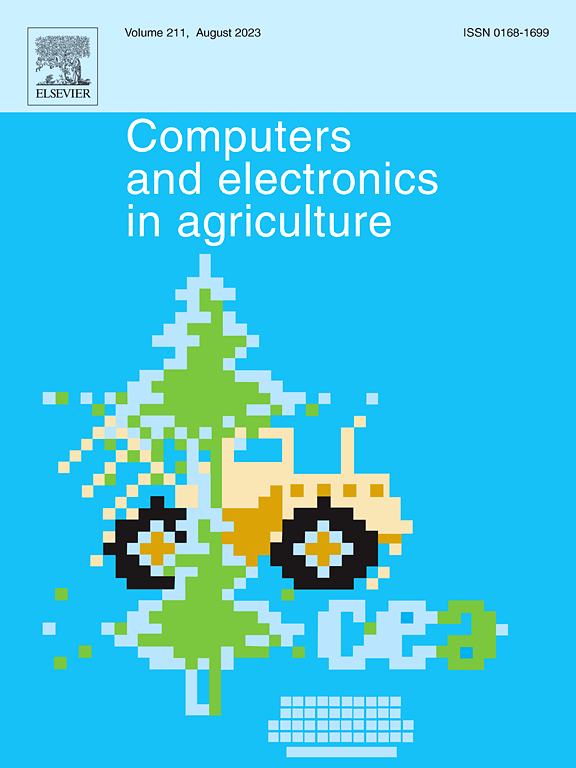Improving picking efficiency under occlusion: Design, development, and field evaluation of an innovative robotic strawberry harvester
IF 8.9
1区 农林科学
Q1 AGRICULTURE, MULTIDISCIPLINARY
引用次数: 0
Abstract
Robotic harvesting has long been seen as the potential alternative to manual harvesting in the strawberry industry. However, despite much progress made in the harvesting process from detection to picking, these technologies are not yet commercially viable. One of the limiting factors for increased performance is fruit occlusion in canopies, particularly in the open-field environments. There has been only limited studies on active occlusion handling/removal techniques during robotic picking. This paper presents the development and evaluation of a strawberry harvesting robot focusing on occlusion handling in open-field environments using vision-based occlusion information and novel end-effector design. The robot was composed of an integrated machine vision system based on deep learning techniques, a 6 DOF manipulator, and an innovative end-effector equipped with a fan system, and a mobile platform. Based on the classification of detected strawberries (‘not occluded’ or ‘occluded’), the robotic platform followed specific steps for directly picking the strawberries (if not occluded) or removing/dispersing the occlusion over the strawberries (if occluded) and subsequently picking them. The effectiveness of this harvesting robot including fruit recognition & localization, and picking method was evaluated using multiple experiments in both the simulation field and the real field. The results showed that the mean average precision in strawberry detection was 80.5% and classification accuracy was 93.2%. Picking efficiency of the robot was enhanced substantially by the use of fan system. In an outdoor strawberry field, the robot achieved a picking rate of 58.1% without fan system, which increased to 73.9% with the fan system (a 15.8% increase in fruit picking rate). It was found that the average processing time of machine vison system was 6.26 s and the overall average time to pick single strawberry with the fan system for removing occlusion was 20.1s.
提高遮挡下的采摘效率:一种创新的机器人草莓收割机的设计、开发和现场评估
长期以来,机器人收割一直被视为草莓行业人工收割的潜在替代品。然而,尽管在从检测到采摘的收获过程中取得了很大进展,但这些技术尚未具有商业可行性。提高性能的限制因素之一是树冠中的果实遮挡,特别是在开阔的田野环境中。在机器人采摘过程中,只有有限的主动遮挡处理/去除技术研究。利用基于视觉的遮挡信息和新颖的末端执行器设计,开发了一种专注于开放环境下遮挡处理的草莓收获机器人。该机器人由基于深度学习技术的集成机器视觉系统、6自由度机械手、配备风扇系统的创新末端执行器和移动平台组成。根据检测到的草莓的分类(“未遮挡”或“遮挡”),机器人平台按照特定的步骤直接采摘草莓(如果未遮挡)或去除/分散草莓上的遮挡(如果遮挡)并随后采摘它们。该收获机器人的有效性包括水果识别;在模拟场和实际场进行了多次实验,对定位和采摘方法进行了评价。结果表明,该方法检测草莓的平均精密度为80.5%,分类精度为93.2%。采用风扇系统,大大提高了机器人的采摘效率。在室外草莓田,机器人在没有风扇系统的情况下采摘率为58.1%,在有风扇系统的情况下,采摘率提高到73.9%(采摘率提高15.8%)。结果发现,机器视觉系统的平均处理时间为6.26 s,风扇去除遮挡系统对单个草莓的整体平均采摘时间为20.s。
本文章由计算机程序翻译,如有差异,请以英文原文为准。
求助全文
约1分钟内获得全文
求助全文
来源期刊

Computers and Electronics in Agriculture
工程技术-计算机:跨学科应用
CiteScore
15.30
自引率
14.50%
发文量
800
审稿时长
62 days
期刊介绍:
Computers and Electronics in Agriculture provides international coverage of advancements in computer hardware, software, electronic instrumentation, and control systems applied to agricultural challenges. Encompassing agronomy, horticulture, forestry, aquaculture, and animal farming, the journal publishes original papers, reviews, and applications notes. It explores the use of computers and electronics in plant or animal agricultural production, covering topics like agricultural soils, water, pests, controlled environments, and waste. The scope extends to on-farm post-harvest operations and relevant technologies, including artificial intelligence, sensors, machine vision, robotics, networking, and simulation modeling. Its companion journal, Smart Agricultural Technology, continues the focus on smart applications in production agriculture.
 求助内容:
求助内容: 应助结果提醒方式:
应助结果提醒方式:


